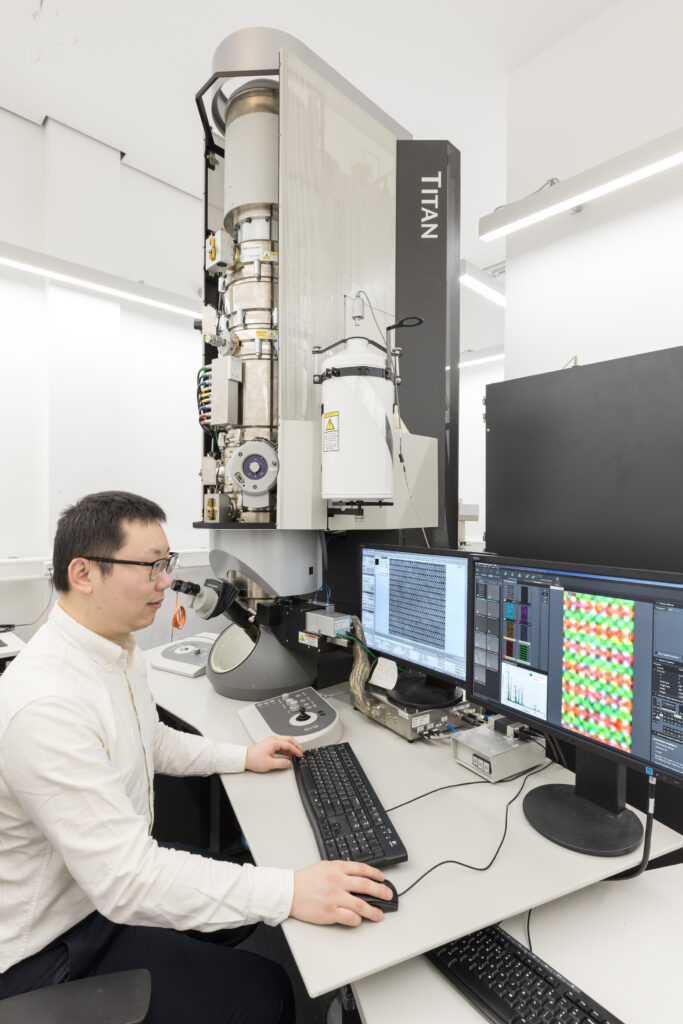FEI Titan G2 80-200 ChemiSTEM

The FEI Titan G2 80-200 ChemiSTEM is a fourth generation transmission electron microscope which has been specifically designed for the investigation of a wide range of solid state phenomena taking place on the atomic scale of both the structure and chemical composition. For these purposes, the FEI Titan G2 80-200 ChemiStem is equipped with a Schottky type high-brightness electron gun (FEI X-FEG), a Cs probe corrector (CEOS DCOR), an in-column Super-X energy dispersive X-ray spectroscopy (EDX) unit (ChemiSTEM technology), a post-column energy filter system (Gatan Enfinium ER 977) with dual electron energy-loss spectroscopy (EELS) option allowing a simultaneous read-out of EDX and EELS signals at a speed of 1000 spectra per second. For data recording the microscope is equipped with angular dark-field (ADF) scanning TEM (STEM) detector (Fischione Model 3000), an on-axis triple BF, DF1, DF2 detectors, an on-axis BF/DF Gatan detectors as well as a 4 megapixel CCD system (Gatan UltraScan 1000 XP-P). Typical examples of use and technical specifications for the instrument are given below.
Typical Applications and Limitations of Use
The configuration of the FEI Titan G2 80-200 ChemiSTEM allows a variety of advanced transmission electron microscopy techniques to be applied to wide variety of solid state materials. These techniques include high-resolution scanning transmission electron microscopy (HRSTEM) with annular detectors for bright-field, annular dark-field, and high-angle annular dark field imaging, electron energy-loss spectroscopy (EELS), energy-dispersive X-ray spectroscopy (EDX), electron tomography (ET), and combinations of the previous techniques. The excellent analytical research possibilities make the instrument an ultimate solution for studies the structure and chemistry of materials in high-spatial resolution.
The FEI Titan G2 80-200 ChemiSTEM is not intended for the investigation of aqueous, contaminated, ferromagnetic or organic samples without further discussions with both of the instruments officers and the ER-C general management.
Sample Environment
Apart from the special case of the utilisation of dedicated cooling or heating stages, the FEI Titan G2 80-200 ChemiSTEM will allow samples to be investigated either under room temperature or liquid nitrogen cooling conditions at a vacuum level of about 10–8 mbar. Besides this standard setup, the sample environment can be adapted to various conditions, e.g. the thermal treatment or the application of external electric or magnetic fields to samples, making use of a wide portfolio of in situ TEM holders available through the ER-C user services. The microscope equipped with a large LN2 dewar, which holds liquid nitrogen for more than three days for optimum conditions around the sample.
Technical Specifications
| Electron acceleration voltage | 80 kV … 200 kV |
| X-FEG brightness @ 200 kV | 1.8×109 A/cm2/sr |
| Symmetrical analytical S-TWIN objective lens | ~ 5 mm |
| Information limit (TEM) @ 200 kV | 110 pm |
| Point resolution (TEM) @ 200 kV | 240 pm |
| Total system drift (TEM) | < 300 pm min-1 (rms) |
| Resolution (STEM) @ 200 kV and 50 pA | < 80 pm |
| Astigmatism instability (TEM) @ 200 kV | < 0.6 nm/min |
| Combined electron probe and sample drift | < 300 pm/min |
| EDX system energy resolution (10 kcps) | < 136 eV @ MnKa |
| EDX solid angle | 0.9 sr |
| EELS system energy resolution @200 kV | 0.65 eV |
Specimen Stages
| Double tilt low background holder | ± 35 ° |
| High field of view single tilt tomography holder | ± 70 ° |
| On axis rotation tomography holder | 360° |
| Further in situ specimen stages available |
